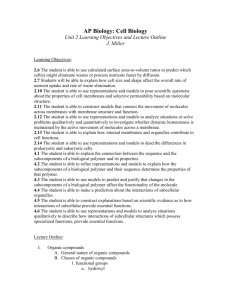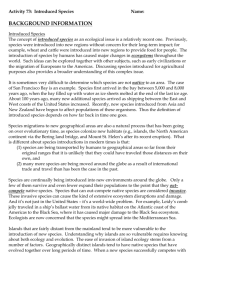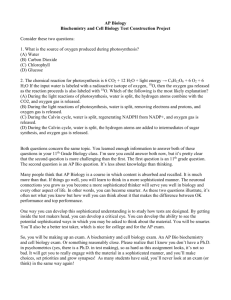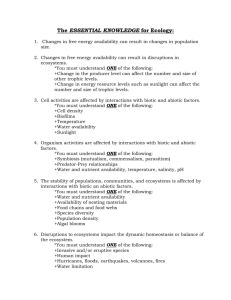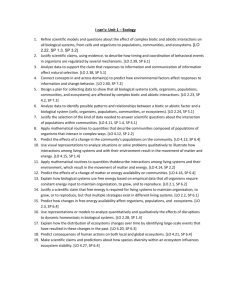Big Idea 4 Learning Objectives: Interactions LO 4.1 The student is
advertisement
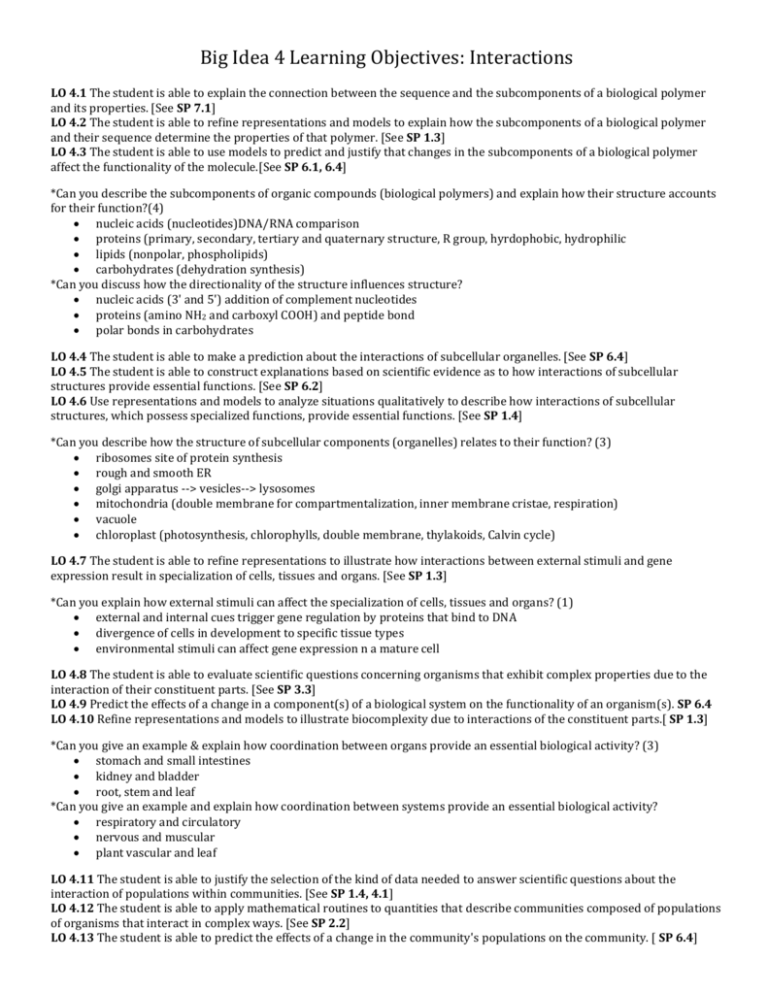
Big Idea 4 Learning Objectives: Interactions LO 4.1 The student is able to explain the connection between the sequence and the subcomponents of a biological polymer and its properties. [See SP 7.1] LO 4.2 The student is able to refine representations and models to explain how the subcomponents of a biological polymer and their sequence determine the properties of that polymer. [See SP 1.3] LO 4.3 The student is able to use models to predict and justify that changes in the subcomponents of a biological polymer affect the functionality of the molecule.[See SP 6.1, 6.4] *Can you describe the subcomponents of organic compounds (biological polymers) and explain how their structure accounts for their function?(4) nucleic acids (nucleotides)DNA/RNA comparison proteins (primary, secondary, tertiary and quaternary structure, R group, hyrdophobic, hydrophilic lipids (nonpolar, phospholipids) carbohydrates (dehydration synthesis) *Can you discuss how the directionality of the structure influences structure? nucleic acids (3' and 5') addition of complement nucleotides proteins (amino NH2 and carboxyl COOH) and peptide bond polar bonds in carbohydrates LO 4.4 The student is able to make a prediction about the interactions of subcellular organelles. [See SP 6.4] LO 4.5 The student is able to construct explanations based on scientific evidence as to how interactions of subcellular structures provide essential functions. [See SP 6.2] LO 4.6 Use representations and models to analyze situations qualitatively to describe how interactions of subcellular structures, which possess specialized functions, provide essential functions. [See SP 1.4] *Can you describe how the structure of subcellular components (organelles) relates to their function? (3) ribosomes site of protein synthesis rough and smooth ER golgi apparatus --> vesicles--> lysosomes mitochondria (double membrane for compartmentalization, inner membrane cristae, respiration) vacuole chloroplast (photosynthesis, chlorophylls, double membrane, thylakoids, Calvin cycle) LO 4.7 The student is able to refine representations to illustrate how interactions between external stimuli and gene expression result in specialization of cells, tissues and organs. [See SP 1.3] *Can you explain how external stimuli can affect the specialization of cells, tissues and organs? (1) external and internal cues trigger gene regulation by proteins that bind to DNA divergence of cells in development to specific tissue types environmental stimuli can affect gene expression n a mature cell LO 4.8 The student is able to evaluate scientific questions concerning organisms that exhibit complex properties due to the interaction of their constituent parts. [See SP 3.3] LO 4.9 Predict the effects of a change in a component(s) of a biological system on the functionality of an organism(s). SP 6.4 LO 4.10 Refine representations and models to illustrate biocomplexity due to interactions of the constituent parts.[ SP 1.3] *Can you give an example & explain how coordination between organs provide an essential biological activity? (3) stomach and small intestines kidney and bladder root, stem and leaf *Can you give an example and explain how coordination between systems provide an essential biological activity? respiratory and circulatory nervous and muscular plant vascular and leaf LO 4.11 The student is able to justify the selection of the kind of data needed to answer scientific questions about the interaction of populations within communities. [See SP 1.4, 4.1] LO 4.12 The student is able to apply mathematical routines to quantities that describe communities composed of populations of organisms that interact in complex ways. [See SP 2.2] LO 4.13 The student is able to predict the effects of a change in the community's populations on the community. [ SP 6.4] Big Idea 4 Learning Objectives: Interactions *Can you discuss and interpret data about the interactions of populations within a community? (4) predator/prey relationships symbiotic relationships introduction of species global climate change models exponential growth logistic growth due to density-dependent limiting factors/ density-independent limiting factors, carrying capacity age distributions LO 4.14 The student is able to apply mathematical routines to quantities that describe interactions among living systems and their environment, which result in the movement of matter and energy. [See SP 2.2] LO 4.15 The student is able to use visual representations to analyze situations or solve problems qualitatively to illustrate how interactions among living systems and with their environment result in the movement of matter and energy. [ SP 1.4] LO 4.16 The student is able to predict the effects of a change of matter or energy availability on communities.[See SP 6.4] *Can you predict the effect of an environmental change on energy flow and matter recycling? (3) climate change with regards to primary productivity food webs and food chains dependent on primary productivity competition for resources logistic growth, density-dependent factors human activities impact, habitat destruction...extinctions adaptations related to acquiring energy in ecosystem LO 4.17 The student is able to analyze data to identify how molecular interactions affect structure and function. [See SP 5.1] *Can you analyze data to identify how molecular interactions affect structure and function? (1) enzyme-substrate, active site, highly specific cofactors, coenzymes allosteric inhibitors concentration of product acts as inhibitor or concentration of substrate affects rate LO 4.18 The student is able to use representations and models to analyze how cooperative interactions within organisms promote efficiency in the use of energy and matter. [See SP 1.4] *Can you explain how organisms' energy efficiency is represented by cooperative interaction within the organism?(1) compartmentalizing of organelles, surface area specialization of organs exchange of gas, circulation of fluids, digestion of food, excretion of waste (choose 1) bacterial community in intestines LO 4.19 The student is able to use data analysis to refine observations and measurements regarding the effect of population interactions on patterns of species distribution and abundance. [See SP 5.2] *Can you analyze data to determine the effect of population interactions on the abundance of species? (1) competition, parasitism, predation, symbiotic relationships cooperation among species loss of keystone species invasive species like kudzu LO 4.20 The student is able to explain how the distribution of ecosystems changes over time by identifying large-scale events that have resulted in these changes in the past. [See SP 6.3] LO 4.21 The student is able to predict consequences of human actions on both local and global ecosystems. [See SP 6.4] *Can you predict consequences of human activity on ecosystems & how distribution of ecosystems changed over time? (2) logging, slash and burn agriculture, urbanization, monocropping, dams, roads introduced species or disease (dutch elm disease, potato blight, small pox) El Nino, continental drift, meteor impact on dinosaurs LO 4.22 The student is able to construct explanations based on evidence of how variation in molecular units provides cells with a wider range of functions. [See SP 6.2] Big Idea 4 Learning Objectives: Interactions *Can you explain how variation in molecular units provides cells with a wider range of function? (1) choose 1 different types of phospholipids in cell membranes different types of hemoglobin MHC proteins Chlorophylls antibody/antigen LO 4.23 Construct explanations of the influence of environmental factors on the phenotype of an organism. [See SP 6.2] LO 4.24 Predict the effects of a change in an environmental factor on the genotypic expression of the phenotype. [See SP 6.4] *Can you give an example and explain how environmental factors influence phenotype and can be an adaptation? (2) height and weight in humans flower color based on pH in soil fur in artic animals UV rays on Melanin production Adding lactose to a bacteria LO 4.25 The student is able to use evidence to justify a claim that a variety of phenotypic responses to a single environmental factor can result from different genotypes within the population. [See SP 6.1] LO 4.26 The student is able to use theories and models to make scientific claims and/or predictions about the effects of variation within populations on survival and fitness. [See SP 6.4] *Can you explain how genetic variation of a population illustrates survival of the fittest and give an example?(2) California condors Prairie chickens Potato blight causing the potato famine Tasmanian devils an infectious cancer LO 4.27 The student is able to make scientific claims and predictions about how species diversity within an ecosystem influences ecosystem stability. [See SP 6.4] *Can you explain how species diversity influences the stability of an ecosystem? (1) Less diversity less resilient (grass lands) Keystone species


